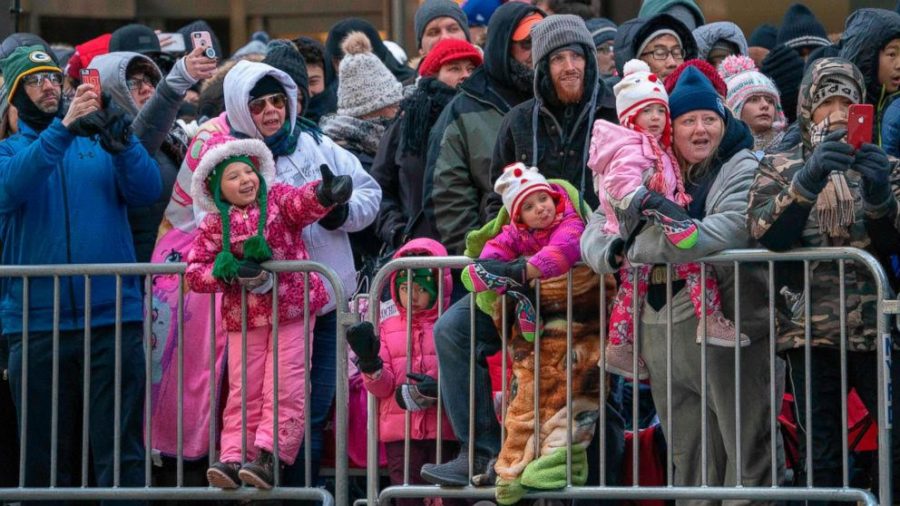A Historically Cold Thanksgiving Should Not Gobble Up Climate Change Issues
By Lydia Parker
“How can you say global warming is an issue when we keep having record-breaking low temperatures in the winter?” Please, let us stop using instances of particularly cold weather as an argument against the very real threat of global warming, which is accompanied by increasingly extreme weather patterns: hot, cold and everything in between. The weather at the most recent Macy’s Thanksgiving Day Parade stands as a poignant example of climate change in action and how important it is that we take notice.
Last week, attendees at New York City’s annual Macy’s Thanksgiving Day Parade experienced the second-coldest temperatures in the parade’s history. According to an article from The New York Times, the lowest temperature recorded on the morning of the parade, 19 degrees, marks the coldest parade conditions since 1901. This was exceeded only by 15-degree weather recorded during the 1871 parade.
Across the Northeastern U.S., record-breaking temperatures led to weather that felt far more appropriate for Christmas than Thanksgiving. Amid coverage of yet another record-breaking weather pattern, the conversation inevitably circled back to climate change.
An especially frustrating misconception surrounding climate change has led to the mentality that global warming only causes hotter weather, prompting arguments from climate change deniers every winter. Especially in the last decade, winters in the Northeastern U.S. have seen record-breaking low temperatures and an increase in extreme winter storm systems.
An article from National Geographic references the infamous incident in which Republican senator Jim Inhofe threw a snowball on the Senate floor in 2015 to disprove the “alarmist conclusion” of human-made climate change. Inhofe challenged the threat of climate change with the perpetuated claim that if global warming is heating up the planet, how can there be record-breaking low winter temperatures?
According to National Geographic, “Uncharacteristically cold winters…just might be one of the most hard felt effects of climate change, according to a study published in Nature Geoscience by a team of researchers.” The study posits “unusually cold temperatures in northern North America and lower precipitation in the south central U.S. all coincided with periods of warmer Arctic weather.”
The article continues, “To reach this conclusion, the researchers analyzed how teleconnections in the Arctic cause cooler winters in North America. Teleconnections are large scale weather anomalies that influence weather across continents and span large portions of the atmosphere.” Perhaps the most well-known of these teleconnection weather patterns in the U.S. are “El Ninos/as.”
On the opposite side of the spectrum of extreme weather patterns seen more frequently in recent years are the wildfires in California.
According to National Geographic, while California’s various ecosystems have evolved to burn naturally in frequent fires, “since the 1980s, the size and ferocity of the fires that sweep across the state have trended upward. Fifteen of the 20 largest fires in California history have occurred since 2000.”
National Geographic continues, “Over the past century, California has warmed by about three degrees Fahrenheit. That extra-warmed air sucks water out of plants and soils, leaving the trees, shrubs and rolling grasslands of the state dry and primed to burn.” Climate change is not drastically increasing the number of wild fires, but contributing to a drier, hotter environment that increases the intensity and spread of the fires.
Though environmental scientists and experts warn against viewing climate change as oversimplified cause and effect situations, it is undeniable that human-caused climate change is contributing to dangerous alterations in our planet’s weather patterns and climate.
A recent, landmark report released by the United Nations (UN) paints a dire picture of Earth’s future if unprecedented efforts are not made to prevent the planet’s temperature from increasing much further. Petteri Taalas, Secretary-General of the World Meteorological Organization (WMO) said, “It is worth repeating once again that we are the first generation to fully understand climate change and the last generation to be able to do something about it.”
Failure to implement wide-reaching changes in environmental policies and practices will lead to extinctions in animal and plant life, and the destruction of the coral reefs. According to an article from the UN, “The key objective is to adopt the implementation guidelines of the Paris Agreement on Climate Change, which aims to hold the global average temperature increase as close as possible to 1.5 degrees centigrade.” While the Intergovernmental Panel on Climate Change (IPCC) maintains that this goal is possible, reaching it “would require ‘unprecedented changes’ in our lifestyle, energy and transport systems.”
As President Trump has reiterated his intention to withdraw from the Paris Agreement, it is increasingly unlikely that the U.S. government will be able to implement the policy changes urged by the Agreement during this current presidency.
Climate change is real and so is the threat that it poses to all forms of life on the planet. The jarringly cold weather experienced by many this past Thanksgiving represents the tip of the iceberg in terms of climate change related weather issues that will affect us if we do not take the necessary steps to slow the damage we are causing to our planet.
Lydia Parker, FCRH ’20, is an English major from Beverly, Massachussetts.










































































































































































































